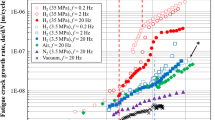Abstract
The relationship of hydrogen, GBF (granular bright facet) and very high cycle fatigue properties of high strength spring steels 60Si2CrV with three different hydrogen contents were studied using hydrogen thermal desorption analysis and ultrasonic fatigue test. The results showed that the influence of hydrogen on the relationship between fatigue life and the ratio of GBF to inclusion size \(\left( {\frac{{\sqrt {{A_{GBF}}} }}{{\sqrt {{A_{INC}}} }}} \right)\) was obvious, and the expression between fatigue life and \(\left( {\frac{{\sqrt {{A_{GBF}}} }}{{\sqrt {{A_{INC}}} }}} \right)\) with different hydrogen contents can also be obtained. In addition, based on the research of hydrogen diffusion and GBF, it was explained why the GBF cannot form below 106 cycles. At last, the estimated critical fatigue life of GBF formation can be expressed accurately.
Similar content being viewed by others
References
Shiozawa K, Lu L, Ishihara S. S-N curve Chiaracteristics and Subsurface Crack Initiation Behaviour in Ultra-long Life Fatigue of a High Carbon-Chironiium Bearing Steel [J]. Fatigue Fract Engng Mater Struc, 2001, 24(12): 781.
Murakami Y, Nomoto T, Ueda T. Factors Influencing the Mechanism of Superlong Fatigue Failure in Steels [J]. Fatigue Fract Engng Mater Struct, 1999, 22(7): 581.
Wang Q Y, Berard J Y, Rathery S, et al. High-Cycle Fatigue Crack Initiation and Propagation Behaviour of High-Strength Spring Steel Wires [J]. Fatigue Fract Engng Mater Struct, 1999, 22: 673.
Shiozawa K. Morii Y, Nishino S. et al. Subsurface Crack Initiation and Propagation Mechanism in High-Strength Steel in a Very High Cycle Fatigue Reginie [J]. Int. J. Fatigue, 2006, 28(11): 1521.
Huang Z, Wagner D. Bathias C. et al. Subsurface Crack Initiation and Propagation Mechanisms in Gigacycle Fatigue [J]. Acta Metall Mater, 2010, 58(18): 6046.
Sakai T, Sato Y, Oguma N. Characteristics S-N Properties of High Carbon Chromium Bearing Steel Under Axial Loading in Long Life Fatigue [J]. Fatigue Fract Engng Mater Struct, 2002, 25(1): 765.
Li W, Sakai T, Li Q, et al. Reliability Evaluation on Very High Cycle Fatigue Property of GCr15 Bearing Steel [J]. Int. J. Fatigue, 2010, 32(7): 1096.
Murakami Y, Yokoyama N N, Nagata J. Mechanism of Fatigue Failure in Ultralong Life Regime [J]. Fatigue Fract Engng Mater Struct, 2002, 25(8/9): 735.
Takai K, Homma Y. Izutsu K. et al. Identification of Trapping Sites in High-Strength Steels by Secondary Ion Mass Spectrometry for Thermally Desorbed Hydrogen [J]. Journal of the Japan Institute of Metals, 1996, 60(12): 1155.
Li S X, Weng Y Q, Hui W J, et al. Very High Cycle Fatigue Properties of High Strength Steels-Effects of Nonmetallic Inclusions [M]. Bejing: Metallurgical Industry Press, 2010 (in Chinese).
Chiapetti M D, Tagawa T. Miyata T. Ultra-long Cycle Fatigue of High-Strength Carbon Steels Part I: Review and Analysis of the Mechanism of Failure [J]. Materials Science and Engineering, 2003, 356A(1): 227.
Billaudeau T, Nadot Y. Support for an Environmental Effecton Fatigue Mechanisms in the Long Life Regime [J]. Int. J. Fatigue, 2004, 26(8): 839.
Li Y D, Yang ZG, Liu Y B. et al. The Influence of Hydrogen on Very High Cycle Fatigue Properties of High Strength Spring Steel [J]. Materials Science and Engineering, 2008, 489A(1): 373.
Furuya Y, Hirukawa H, Hayakawa M. Gigacycle Fatigue Properties of Hydrogen-Chiarged JIS-SCM440 Low-Alloy Sted Under Ultrasonic Fatigue Testing [J]. Metall Mater Trans, 2010, 41A(9): 2248.
Liu Y B, Li S X, Li Y D, et al. Factors Influencing the GBF Size of High Strength Steels in the Very High Cycle Fatigue Regime [J]. Materials Science and Engineering, 2011, 528A: 935.
Carneiro Filho C J, Mansur M B, et al. The Effect of Hydrogen Release at Room Temperature on the Ductility of Steel Wire Rods for Pre-Stressed Concrete [J]. Materials Science and Engineering, 2010, 527A(18/19): 4947.
Chiapetti M D, Tagawa T, Miyata T. Ultra-long Cycle Fatigue of High-Strength Carbon Steels Part II: Estimation of Fatigue Limit for Failure From Internal Inclusions [J]. Materials Science and Engineering, 2003, 356A(1): 236.
Nagao A, Kuranioto S, Ichitani K, Kanno M. Visualization of Hydrogen Transport in High Strength Steels Affected by Stress Fields and Hydrogen Trapping [J]. Scripta Materialia, 2001, 45(10): 1227.
Yu Y, Gu J L, Bai B Z, et al. Very High Cycle Fatigue Mechanism of Carbide-Free Bainite/Martensite Steel [J]. Materials Science and Engineering, 2009, 527A(1): 212.
Yang Z G, Li S X, Liu Y B, et al. Estimation of the Size of GBF Area on Fracture Surface for High Strength Steels in Very High Cycle Fatigue Reginie [J]. Int. J. Fatigue, 2008, 30(6): 1016.
Author information
Authors and Affiliations
Corresponding author
Rights and permissions
About this article
Cite this article
Zhou, C., Zhang, Yj., Hui, Wj. et al. Influence of Hydrogen on GBF in Very High Cycle Fatigue of High Strength Steel. J. Iron Steel Res. Int. 20, 92–97 (2013). https://doi.org/10.1016/S1006-706X(13)60221-6
Received:
Published:
Issue Date:
DOI: https://doi.org/10.1016/S1006-706X(13)60221-6




